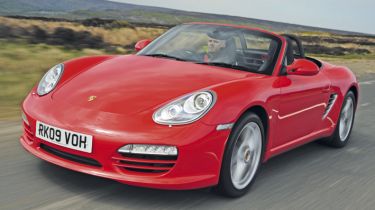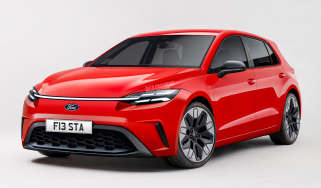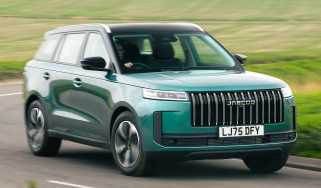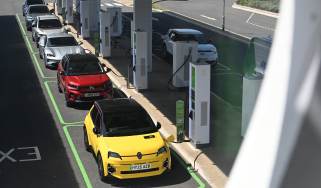Porsche Boxster
Class leader trades on firm’s talents for sharp handling
On face value, the Porsche Boxster follows the same format as the BMW and Mercedes. As with its competitors, the recently revised model is a two-seater convertible which is powered by a six-cylinder engine and has a price of around £30,000.
Take a closer look, though, and it’s clear that the engineers at Porsche have done things slightly differently. The German firm’s entry-level model has been built with driving thrills in mind, so the unit is mid-mounted for better balance. A traditional fabric hood is also fitted to save weight. And if that wasn’t enough, a recent round of mechanical tweaks means the Boxster should be more exciting to drive than ever.
That’s good news, as you’re unlikely to pick the Porsche solely because of its looks. While it isn’t unattractive, it doesn’t have the elegant roadster lines of the other two cars here. That centrally mounted powerplant results in a squat and compact stance that is more purposeful than pretty.
New lights front and rear help to freshen up the design, but the overall look has remained largely unchanged since the model’s 1996 debut. Matters improve once you slide into the low-slung cabin. The driving position is perfect, while the beautifully built interior is logically laid out and full of useful storage spaces.
Used - available now

2024 Nissan
Ariya
12,471 milesAutomaticElectric
Cash £25,490
2021 Lexus
UX 300e
39,392 milesAutomaticElectric
Cash £16,950
2023 Hyundai
i30
23,040 milesManualPetrol1.0L
Cash £14,801
2021 Vauxhall
Mokka
16,283 milesAutomaticPetrol1.2L
Cash £15,795Remarkably, the well insulated, electrically operated fabric roof is nearly as effective at keeping out noise as the metal units of the Z4 and SLK. The only downside is that when in place it restricts over-the-shoulder vision, which can be a problem when pulling out from tight junctions.
This is less of an issue when the hood is stowed – an operation that takes only 12 seconds once you’ve released the surprisingly stiff safety catch. Even better, lowering the roof doesn’t reduce the available luggage space. With deep boots front and rear, the Boxster can swallow an impressive total of 280 litres.
But this test is more about performance than practicality – and in this respect the Porsche doesn’t disappoint. With its new 251bhp 2.9-litre engine, the Boxster is the most powerful car of our trio, and it has an immediate advantage at the test track. It covered the benchmark 0-60mph sprint in six seconds exactly; both the Mercedes and BMW were four-tenths slower.
The Porsche’s punchy in-gear acceleration is even more impressive and makes light work of overtaking slower traffic. But it’s the eye-popping power of the brakes that really makes a mark, hauling the car from 70mph to a stop in only 43.1 metres. Turn into a corner and the Porsche feels extremely direct and agile. Its controls are perfectly weighted and the steering is brimming with feedback, making the model extremely involving on a twisting back road.
Working the flat-six powerplant is exhilarating, too, as it has the same hard-edged metallic howl made famous by the company’s legendary 911. Only around town does the Boxster become hard work. The low-speed ride is very firm, meaning bumps and potholes can send a shudder through the cabin.
Another jarring experience is the £33,704 price tag, which makes the Porsche the most expensive car here. The question is whether such a strong blend of abilities can help the Boxster overcome this financial disadvantage to beat its clever metal-roofed rivals.
Details
Chart position: 1
WHY: Few cars can match the Porsche for driving thrills. Recent facelift has tweaked looks and added power.



